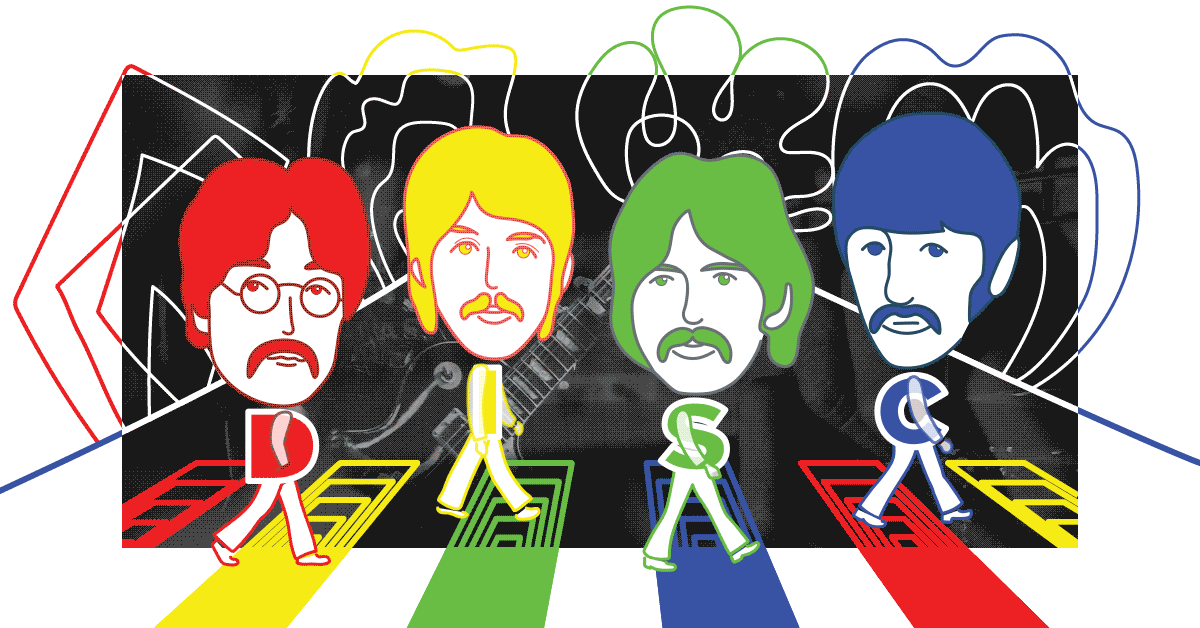How Lennon and McCartney Used Collaboration and Competition to Create Genius
John Lennon and Paul McCartney, it can be argued, formed the greatest songwriting partnership in the history of recorded music. The Beatles changed the world in their eight years as a popular music powerhouse. On the surface, the two may seem like two peas in a pod. In reality, John and Paul couldn’t have been more opposite, when viewed from a behavior and driver perspective.
As the staff writer for an assessment solutions company, I am intrigued to study how different behavioral styles and motivators can work together to create greatness. And who better to study than the brains behind arguably the greatest band of all-time?
While George Harrison and Ringo Starr certainly contributed to the group (especially in the later years), it was McCartney and Lennon that did the majority of the songwriting and were the engine that powered The Beatles music machine.
After being inspired by reading a thought-provoking article about the differing personalities of the two lead Beatles, I was motivated to compare and contrast Lennon and McCartney from a perspective of behaviors.
The article is entitled The Power of Two, written by Joshua Wolf Shenk of The Atlantic, a great read for anyone who considers themselves a fan of The Beatles.
Proving that opposites certainly do attract - and have the ability to work fantastically together - comparing the behaviors of these two musical geniuses and the drivers behind those behaviors sheds insight on how their individual opposing forces were often the fuel that brought out the greatness in both men’s songwriting.
Behaviors form early
While John was just twenty months older than Paul, the age gap was significant enough to position John as somewhat of an “alpha dog” during the two boys’ formative teenage years. John was 100% rebel, moving to the beat of his own drum from the very beginning. John lived in the moment and did as he pleased, without much care or concern for future repercussions.
Paul, on the other hand, was a proper and polite young gentleman, well-schooled and respectful. Paul came from a loving family, while John was raised by a strict aunt who cared for him after his father left and his mother decided she wasn’t cut out for the job. While John’s aunt had his best interests at heart, her style of parenting left John more resentful than appreciative.
When the two boys met sometime around 1957, a magnetic pull occurred instantly. John was the rebellious older boy that did as he pleased, which appealed to the well-behaved Paul. Conversely, Paul’s musical ability was equal, or even superior, to John’s.
Paul’s ability to be able to keep up with and push John appealed to his competitive nature. John, whether he’d openly admit or not, was somewhat envious of Paul’s stable household while Paul often wondered what it would be like to break some rules once in awhile.
Competition vs. collaboration
The two were virtually inseparable from the time they met until the later years of The Beatles. They could often be seen with their guitars in hand, learning popular songs of the day or creating songs of their own. Both Liverpool lads had wildly-creative minds and ideas flowed like fountains from both of them.
One would create a song idea and the other would have an equally compelling idea to complete the song. John and Paul thrived on collaboration, and what they accomplished together was leaps and bounds above what they would have seemingly accomplished individually. In this case, 1+1=3. There was John, there was Paul and there was a third force that was created when the two worked together.
Their collaborative genius can be seen in what many consider to be the Beatles greatest song, A Day In The Life, where both members came to the table with parts of incomplete songs. While vastly different in musical composition, the pair fused these parts together to create an epic masterpiece that defines their greatness.
In writing the psychedelic Lucy in the Sky with Diamonds, it is said that they “volleyed” lines back and forth, coming up with ideas with ease, creating the definition of a true collaboration.
Interestingly, competition also drove the pair. During the Beatles’ heyday, when everything the band wrote became a hit, they began to write significant parts of songs, or even entire songs, on their own.
When John appeared in the studio one day with Strawberry Fields Forever, a melancholy reflection of his childhood, Paul immediately answered with Penny Lane; an interpretation of his childhood.
Always trying to “one-up” each other, the pair kept raising the stakes on what it meant to write a great song. Because of this, the songs kept getting better all the time.
When they weren’t competing with each other, they were teaming up to compete against other rival bands. The Beach Boys were their main competition, battling The Beatles in the early and mid-60s for chart supremacy. When the Beach Boys’ Brian Wilson wrote his signature classic God Only Knows, Paul answered with his touching ballad Here, There and Everywhere.
The competition wasn’t confined to the music either. Shortly after Lennon broke the unwritten rules of bringing an outsider (Yoko Ono) into the studio, McCartney quickly followed suit introducing Linda Eastman. When Paul married Linda, John and Yoko also married, a mere eight days later.
Comparing behaviors
Paul was meticulous and organized; he was known for always carrying a notebook with him should inspiration hit him while he was on the move.
Known for his neat handwriting, and equally smooth communication skills, Paul usually had a plan and a specific method for doing things. He was willing to put in the long hours to accomplish his goals. He’d see ideas through to completion and was known to be somewhat set in his ways.
John was the opposite of organized, scrambling to find scraps of paper to jot down unreadable notes when inspiration struck him. He didn’t have a set method for going about his tasks, he was open to go with the flow and enjoyed constantly trying new things.
He liked to move quickly from song to song and project to project, having a high sense of urgency. If an idea of his morphed into something different than he originally imagined, he was open to the change. This was unlike Paul who would often take offense when someone would critique one of his ideas.
Being a natural communicator, and usually having a calculated purpose in mind, Paul was a perfect fit for the press. Always prepared, he was engaging and he gave them exactly what they were seeking.
This made him a media darling. It also helped counteract John’s sometimes harsh, if not crude, approach with the same media members. John could get away with his rebellious attitude because of Paul’s opposite manner. Together, the two made it work.
John’s first wife Cynthia Lennon was known for saying “John needed Paul’s persistence and attention-to-detail while Paul needed John’s anarchic, lateral thinking.” They each had strengths and weaknesses and it seemed, in many regards, one’s strength was the other one’s weakness. That’s why things worked so well for John and Paul.
While the two did share many things in common, it seemed their opposing behaviors and drivers are what really propelled them to a place no band had ever reached previously.
In part two of this blog, we will define the different behaviors and motivators John and Paul possessed, highlighting their similarities and differences, and the adaptations they needed to make, to make them the songwriting force that changed a generation.

Dave Clark
As both a writer and a musician, Dave Clark enjoys exploring areas where he can express his creativity, which is influenced by his strong Harmonious Driving Force.

/How%20Behaviors%20and%20Drivers%20Influenced%20the%20Greatest%20Songwriting%20Team%20in%20History.png?width=374&name=How%20Behaviors%20and%20Drivers%20Influenced%20the%20Greatest%20Songwriting%20Team%20in%20History.png)

/Bohemian%20Rhapsody%20-%20The%20Contrasting%20Personalities%20of%20Queen.png?width=374&name=Bohemian%20Rhapsody%20-%20The%20Contrasting%20Personalities%20of%20Queen.png)
0 Comments